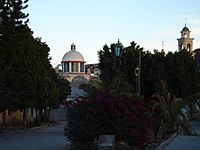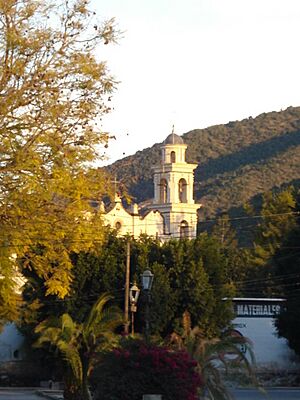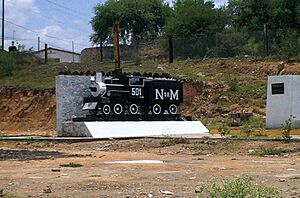Cárdenas, San Luis Potosí facts for kids
Quick facts for kids
City of Cárdenas
Ciudad de Cárdenas
|
|
|---|---|
|
city
|
|

Downtown Cárdenas
|
|
| Nickname(s):
La ciudad del ferrocarril (The railway city)
|
|
| Country | Mexico |
| State | San Luis Potosí |
| Founded | 17th century |
| Elevation | 1,200 m (3,900 ft) |
| Population
(2005)
|
|
| • Total | 20,000 |
| Time zone | UTC-6 (Central Standard Time) |
| • Summer (DST) | UTC-5 (Central Daylight Time) |
| Website | www.cardenas-slp.gob.mx/ |
Cárdenas is a city and a municipality in the Mexican state of San Luis Potosí. It is located east of the state capital in an area called the Middle Zone.
Cárdenas is about 1,200 meters (3,937 feet) above sea level. It shares borders with Alaquines to the north, Tamasopo to the east, Rayon to the south, and Río Verde to the west. The city of San Luis Potosí is about 200 kilometers (124 miles) away. With around 20,000 people, Cárdenas is the second largest city in the Middle Zone.
Contents
A Look Back: Cárdenas History
The first people to settle in this area were friars in the early 1600s. They lived on farms and large estates, including one called Ciénega de San Nicolás. This estate was supposedly started by someone named Luis de Cárdenas.
Because of its owner, the area was first known as the Ciénega de San Nicolás. Later, it became known as the Hacienda de Cárdenas.
How Cárdenas Began
For over a hundred years, the Cárdenas family owned the hacienda. During this time, more and more families moved there. Most of these families were Pames, and only a few spoke Spanish. They didn't live in one big town but were spread out in many small farming communities. Friars from the mission in Alaquines would visit to help with religious matters.
In 1761, Don Manuel Antonio Rojo del Río, Lafuente and Vieyra owned the Ciénega hacienda. Later, it was sold and passed through the hands of Félix María Calleja and then Don Felipe Barragán. After Don Felipe died, his daughters, Juana and Luisa Barragán, became the owners.
During the Mexican War of Independence, some battles happened in the Cárdenas hacienda area.
The Railway Arrives
In 1881, a big project began that would change Cárdenas forever: the railway. The plan was to build train tracks from San Luis Potosí all the way to Tampico. Building the railway was slow and difficult. There were many stops and starts, money problems, and legal issues.
Workers had to overcome tough mountains between Tamasopo and the Highlands. They built several tunnels right through the mountains! This amazing work finally brought the tracks to what is now Cárdenas in April 1890.
After the railway arrived, life in Cárdenas completely changed. Train workshops were built, and the city's population grew quickly. New neighborhoods like Rasconcito and Colonia Americana were created. The economy boomed as many families moved in from nearby places like Alaquines, Rayón, and Lagunillas. It was an exciting time for the whole region, lasting until 1910.
In 1911, Cárdenas saw some early events of the Mexican Revolution. Forces led by Higinio Olivo and Juan Torres Pérez were active. Later, in 1912, the Cedillo brothers (Magdaleno, Saturnino, and Cleofas) also became involved in the revolution.
In 1914, the Cedillo forces took control of Cárdenas. They used the railway station and trains. A major battle in Cárdenas during the Mexican Revolution happened on May 27, 1917. The city was defended by soldiers led by Colonel Fidel Garza. The Cedillo forces attacked, and fighting spread through the town. They took over the railway buildings and tried to burn down the station.
Cárdenas Geography
Size of Cárdenas
According to information from INEGI in 2000, the total area of the Cárdenas municipality is about 384.26 square kilometers (148.36 square miles). This makes up about 0.63% of the entire state of San Luis Potosí.
Mountains and Hills
In the Cárdenas municipality, you can find several mountain ranges and peaks. These include the Sierra de Santa Gertrudis, Sierra Paredes, El Picacho, El Azafrán, Catana, and El Grande.
Weather in Cárdenas
Cárdenas gets about 616.6 millimeters (24.28 inches) of rain each year. The weather varies across the region. In the west, it's mostly semi-dry and semi-warm. In the center, it's semi-warm with some humidity. In the east, it's semi-warm and humid with rain mostly in the summer.
The average temperature throughout the year is about 26.9°C (80.4°F). In summer, temperatures can reach a high of 47°C (116.6°F), while in winter, they can drop to a low of 5°C (41°F).
Nearby Cities
Cárdenas is close to several other cities, including:
- San Luis Potosí
- Alaquines
- Rioverde
- Ciudad Valles
Mayors of Cárdenas
Here are some of the people who have served as mayors of Cárdenas:
- José García Ramos (1951-1952)
- Melquiades Castillo (1953-1955)
- Felipe Castillo Vega (1956-1958)
- J. Trinidad García Ramos (1959-1961)
- René Castillo Vega (1962-1964)
- Enrique Palau Zuñiga (1965-1967)
- Carlos Guzmán (1968-1970)
- Jaime Rodríguez Lara (1971-1973)
- José López Rubio (1974-1976)
- Enrique Zubiaga Ramírez (1977-1979)
- René Castillo Vega (1980-1982)
- Ernesto Torres Alvarado (1983-1985)
- Indalecio Medina Calderón (1986-1988)
- Amonario Díaz de León (1992-1994)
- Arturo Hernández Maltus (1995-1997)
- Nicolás Torres Torres (1997-2000)
- Jaime Macías Oviedo (2000-2003)
- Agustín Pérez Gómez (2004-2006)
- José Luis Montaño Chávez (2006–Present)
Famous People from Cárdenas
Many talented people have come from Cárdenas:
- E. Blas Rodriguez (1880-1949): He wrote important studies about history, archaeology of the Huasteca region, and legal topics.
- Jesus Maria Colunga (1845-1891): He became a priest in 1871 and served in many churches.
- Higinio Olivo (-1915): He was a revolutionary who joined different groups during the Mexican Revolution, eventually becoming a colonel.
- Miguel Ángel Herrera (1932-2006): He published a book called "Cárdenas My Memories." He was also a writer for newspapers and magazines, a member of the Potosian Historical Academy, and the official historian for Cárdenas. He won a history prize in 1984.
- Idelfonso Turrubiartes (1890-1963): He joined the Cedillo brothers' forces in 1911. After the Revolution, he became a Brigadier General. He served as Governor of San Luis Potosí from 1931 to 1935, and during his time, the University gained more independence.
- Fernando Z. Maldonado: He was a famous composer from Cárdenas. He wrote many popular songs, including "Volver, Volver," which became famous by Vicente Fernández. Other songs he composed include "Not Keep Crying," "Looks Like," and "Love in the Street."
- Marina Herrera Aragón "Marilú, la Muñequita que Canta" (born 1927): She is a well-known bolero singer and actress. She was active during the Golden Age of Mexican cinema and also performed on radio, stage, and television.



